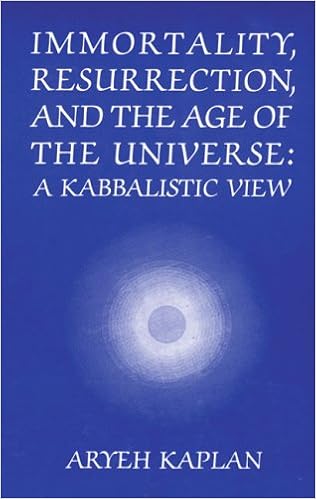
Rabbi Aryeh Kaplan (1934-1983), the author of the mystical book “Immortality, Resurrection, and the Age of the Universe,” was an American Orthodox rabbi who was acclaimed for his many books, about fifty in all, his knowledge of physics, and Jewish mysticism. He worked initially as a physicist, but in 1965, when he was around thirty years old, he changed careers and began to practice as a rabbi. He secured his rabbinical ordination from rabbis in Israel. He stressed the mystical harmony of science and religion in his writings.
This book, published in 1993, a decade after his death, contains his mystical views about the age of the universe, the reasons for the long lives of many early biblical figures before the flood which was only slightly reduced after the flood and then reduced even further, immortality in Judaic sources, resurrection, astrology, the effect of stars on humans, angels, and the reason for the religious differences between men and women, which he felt was proper.
None of these subjects are explicitly mentioned in the Torah, and arguably not even hinted at.[1] Yet, today many Jews believe in all of them, even rationally thinking Jews. Rabbi Kaplan offers his views on each from mystical sources. He starts with the notion that whatever the ancients said is true, even the somewhat absurd narratives in midrashim, which others, such as Maimonides assert should not be taken literally for they are only parables designed to teach moral lessons.[2] Kaplan also asserts that every statement made by an ancient rabbi is true even if the majority of rabbis, even those far smarter than he, disagreed with what the rabbi said. With these two ideas as his base, Rabbi Kaplan contends that he is able to prove the truthfulness of each of the ideas he is discussing.
Relying on a kabbalistic book, Sefer ha-Temunah, “Book of the Figure,” traditionally composed in the first century but actually written around 1270, a book rejected by other mystics, Rabbi Kaplan asserts that there were other worlds before Adam and Eve were created. These worlds were populated by people who were still alive when Adam and Eve were born.[3] Thus, because of the information in this mystical book, Judaism can accept the scientific finding that the world is millions of years old.
Rabbi Kaplan explains that originally the descendants of Adam and Eve were meant to live a long life, but they began to intermarry with the pre-Adam primitive humans and this was the cause of the reduction in their lifespan.[4]
He argues that science proves that resurrection is possible, for we see that we are able to clone animals. He adds that humans can be cloned by using the DNA of the dead person and when the DNA is not available “it will be restored prophetically.” And “the soul and its memories would have to be supplied by God Himself.”
He believed in the efficacy and truthfulness of astrology and writes that it is “a combination of science and the supernatural.” He describes stars as divine creations that have angels associated with them, and the stars and their angels influence humans, which can be verified “as we probe into our classical texts.”
The rabbi asserts that Jewish law is different for men and women because Eve and her female descendants’ ability to think was reduced when Eve ate from the forbidden tree. Men, he asserts, are able to learn from past experiences, an ability, he states, women lack.
Rabbi Kaplan’s book is only 64 pages long. It is followed in this volume by a long sermon by the mystic Rabbi Israel Lipschitz (1782-1860), delivered by him in 1842, 67 pages long, which addresses most of the same subjects and defends the assertions with essentially the same supports and opinions as those by Rabbi Kaplan.
[1] Some scholars assert that the late book Daniel, in chapter 12, speaks about resurrection, but others contend that Daniel is not speaking about individuals but the nation of Israel.
[2] In his essay called Chelek, Maimonides stated that anyone who takes midrashim as the truth is a fool and so are those who dismiss the midrashim entirely since they are not true, because the rabbis wrote the fables as parables to teach lessons.
[3] Around 1550, the famed Rabbis Moses Cordovero and Isaac Luria, known as the Holy Ari, rejected this view. Kaplan notes the disagreement
[4] Based on the Midrash Bereshit Rabbah 26:5.
No comments:
Post a Comment